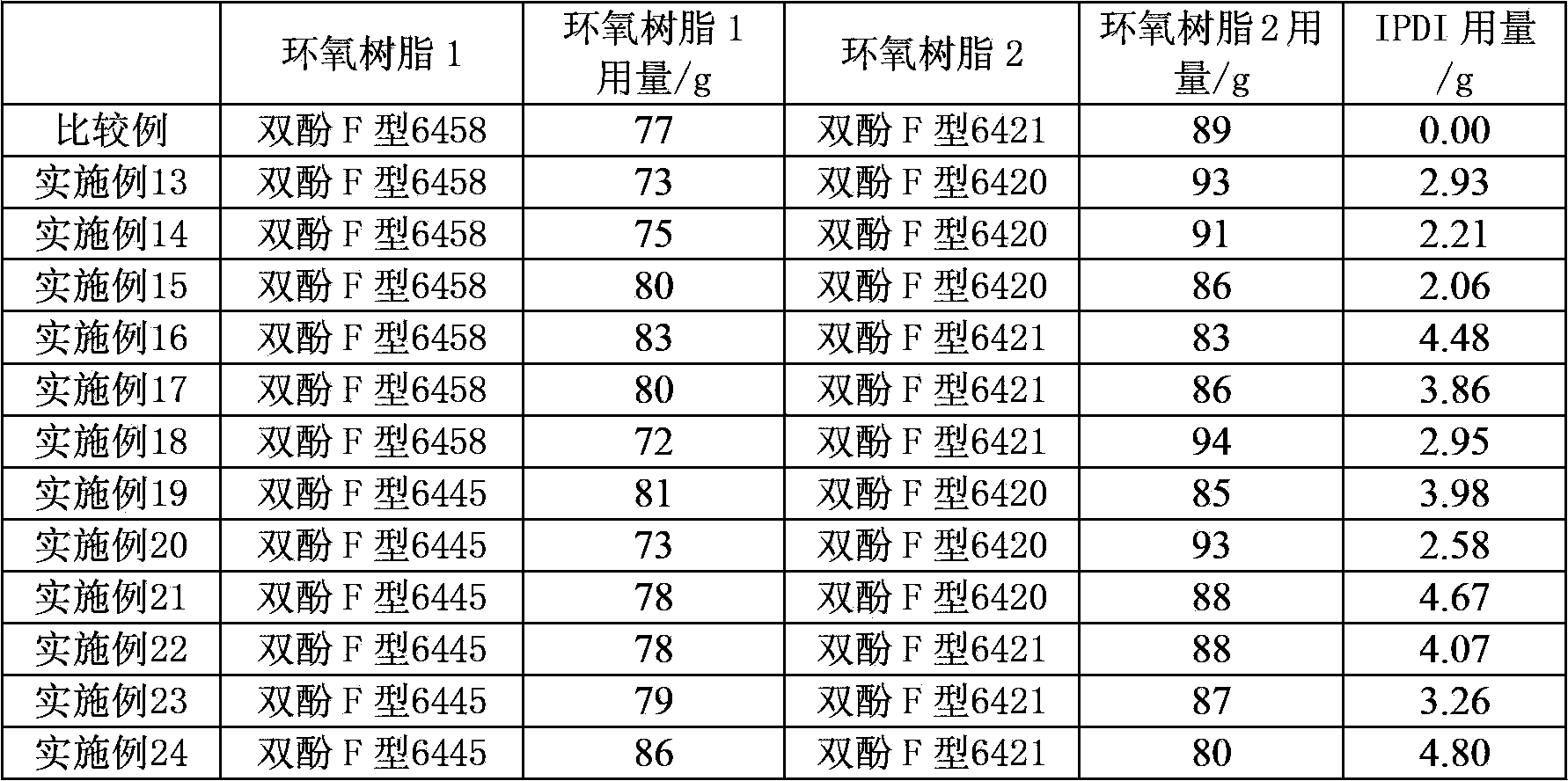Polyurethane-structure-modified bisphenol F epoxy resin composite, as well as preparation and application thereof
A technology of epoxy resin and polyurethane, applied in textiles and papermaking, fiber treatment, fiber type, etc., can solve problems such as lack of fiber opening and expansion performance, restriction of sizing agent engineering application, poor clustering and wear resistance, etc. Achieve the effects of improving process permeability, improving clustering and wear resistance, and realizing industrial production
- Summary
- Abstract
- Description
- Claims
- Application Information
AI Technical Summary
Problems solved by technology
Method used
Image
Examples
Embodiment 1-12
[0024] Put the quantitative epoxy resin mixture in a 250ml four-neck flask with a mechanical stirring device, heat to 110°C, control the vacuum pressure at 100-0.1mmHg, and vacuum dehydrate for 2 hours until no bubbles are generated. Cool down to 70°C, remove the vacuum device, and insert a condenser tube. Under the protection of high-purity nitrogen, a quantitative amount of hexamethylene diisocyanate (HDI) was slowly added dropwise into the flask with a micro metering pump. After the dropwise addition, it was reacted at 70°C for 1 hour, and then the temperature was raised to 95°C. ℃ for more than 2 hours, sampling for infrared analysis, when the result shows that there is no -NCO group, a polyurethane structure-modified bisphenol F epoxy resin composition is prepared. The type and amount of epoxy resin mixture used, and the amount of hexamethylene diisocyanate (HDI) are shown in Table 1.
[0025] Table 1, raw material quality table for reaction
[0026]
[0027]
Embodiment 13-24
[0029] Put the quantitative epoxy resin mixture in a 250ml four-neck flask with a mechanical stirring device, heat to 110°C, control the vacuum pressure at 100-0.1mmHg, and vacuum dehydrate for 2 hours until no bubbles are generated. Cool down to 70°C, remove the vacuum device, and insert a condenser tube. Under the protection of high-purity nitrogen, a quantitative amount of isophorone diisocyanate (IPDI) was slowly added dropwise to the flask with a micro metering pump. After the dropwise addition, it was reacted at 70°C for 1 hour, and then heated to 95°C After reacting for more than 2 hours, samples were taken for infrared analysis, and when the results showed that there was no -NCO group, a polyurethane structure-modified bisphenol F epoxy resin composition was prepared. The type and amount of epoxy resin mixture used, and the amount of isophorone diisocyanate (IPDI) are shown in Table 2.
[0030] Table 2, raw material quality table for reaction
[0031]
Embodiment 25-36
[0033] Put the quantitative epoxy resin mixture in a 250ml four-neck flask with a mechanical stirring device, heat to 110°C, control the vacuum pressure at 100-0.1mmHg, and vacuum dehydrate for 2 hours until no bubbles are generated. Cool down to 50°C, remove the vacuum device, and insert a condenser tube. Under the protection of high-purity nitrogen, a quantitative amount of diphenylmethane diisocyanate (MDI) was slowly added dropwise into the flask with a micrometering pump. After the dropwise addition, it was reacted at 50°C for 1 hour, and then heated to 85°C. After reacting for more than 2 hours, samples were taken for infrared analysis, and when the results showed that there was no -NCO group, a polyurethane structure-modified bisphenol F epoxy resin composition was prepared. The type and amount of epoxy resin mixture used, and the amount of diphenylmethane diisocyanate (MDI) are shown in Table 3.
[0034] Table 3, raw material quality table for reaction
[0035]
PUM
 Login to View More
Login to View More Abstract
Description
Claims
Application Information
 Login to View More
Login to View More - R&D
- Intellectual Property
- Life Sciences
- Materials
- Tech Scout
- Unparalleled Data Quality
- Higher Quality Content
- 60% Fewer Hallucinations
Browse by: Latest US Patents, China's latest patents, Technical Efficacy Thesaurus, Application Domain, Technology Topic, Popular Technical Reports.
© 2025 PatSnap. All rights reserved.Legal|Privacy policy|Modern Slavery Act Transparency Statement|Sitemap|About US| Contact US: help@patsnap.com



